Kathmandu Holdings Limited: Marketing Analysis, Strategies, Target
VerifiedAdded on 2023/06/07
|9
|1897
|156
Report
AI Summary
This report provides a marketing analysis of Kathmandu Holdings Limited, a retail chain specializing in travel apparel and equipment. It examines the company's background, product and service offerings, and target market. Kathmandu focuses on quality products and innovation to meet customer demands, primarily targeting tourists and individuals interested in hiking, cycling, and trekking, aged 25-40, from middle to upper-middle-income groups. The company's diverse product range, including waterproof jackets, sleeping bags, and camping accessories, caters to both male and female customers. Kathmandu also leverages government-sponsored events and digital integration to gather customer feedback and refine its product development and marketing strategies.
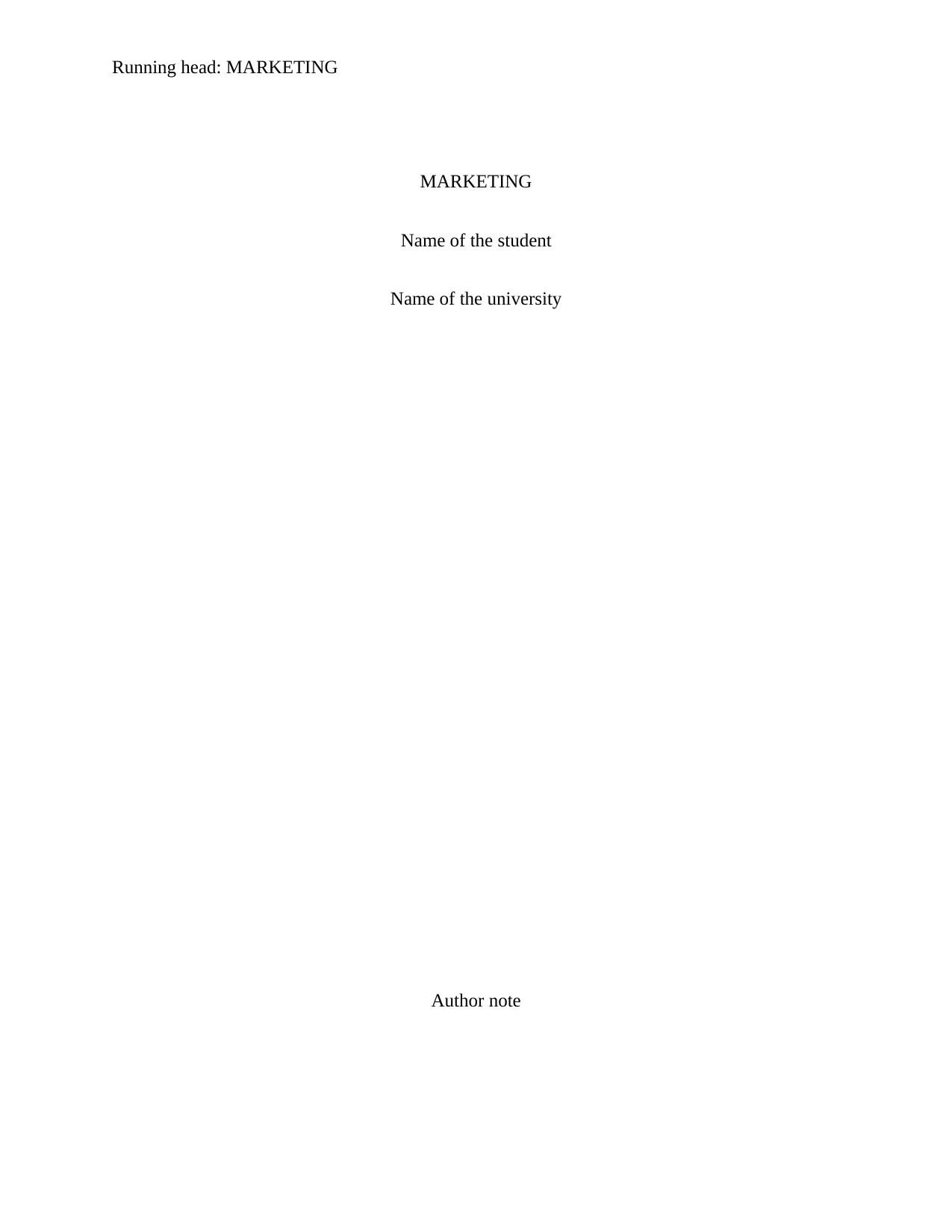
Running head: MARKETING
MARKETING
Name of the student
Name of the university
Author note
MARKETING
Name of the student
Name of the university
Author note
Paraphrase This Document
Need a fresh take? Get an instant paraphrase of this document with our AI Paraphraser
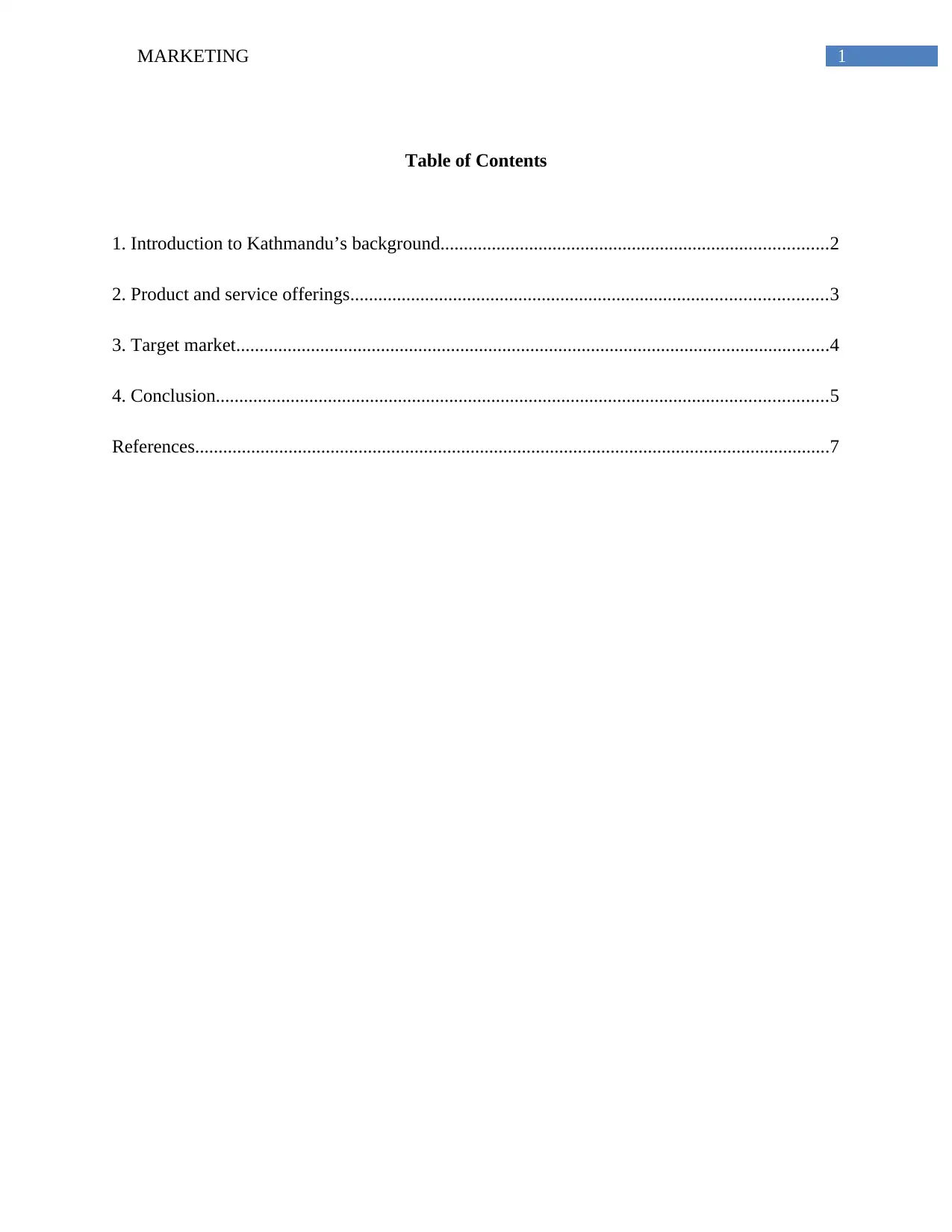
1MARKETING
Table of Contents
1. Introduction to Kathmandu’s background...................................................................................2
2. Product and service offerings......................................................................................................3
3. Target market...............................................................................................................................4
4. Conclusion...................................................................................................................................5
References........................................................................................................................................7
Table of Contents
1. Introduction to Kathmandu’s background...................................................................................2
2. Product and service offerings......................................................................................................3
3. Target market...............................................................................................................................4
4. Conclusion...................................................................................................................................5
References........................................................................................................................................7
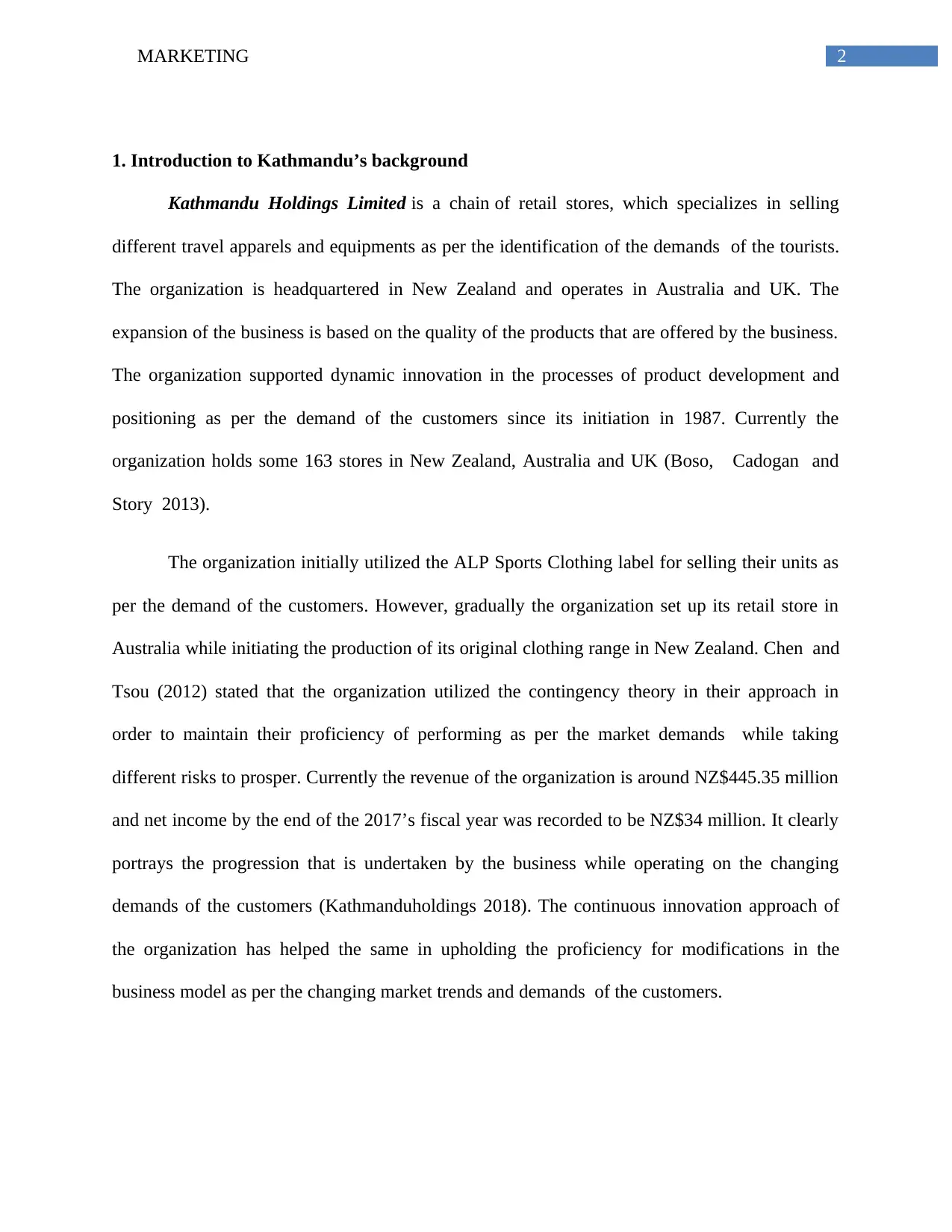
2MARKETING
1. Introduction to Kathmandu’s background
Kathmandu Holdings Limited is a chain of retail stores, which specializes in selling
different travel apparels and equipments as per the identification of the demands of the tourists.
The organization is headquartered in New Zealand and operates in Australia and UK. The
expansion of the business is based on the quality of the products that are offered by the business.
The organization supported dynamic innovation in the processes of product development and
positioning as per the demand of the customers since its initiation in 1987. Currently the
organization holds some 163 stores in New Zealand, Australia and UK (Boso, Cadogan and
Story 2013).
The organization initially utilized the ALP Sports Clothing label for selling their units as
per the demand of the customers. However, gradually the organization set up its retail store in
Australia while initiating the production of its original clothing range in New Zealand. Chen and
Tsou (2012) stated that the organization utilized the contingency theory in their approach in
order to maintain their proficiency of performing as per the market demands while taking
different risks to prosper. Currently the revenue of the organization is around NZ$445.35 million
and net income by the end of the 2017’s fiscal year was recorded to be NZ$34 million. It clearly
portrays the progression that is undertaken by the business while operating on the changing
demands of the customers (Kathmanduholdings 2018). The continuous innovation approach of
the organization has helped the same in upholding the proficiency for modifications in the
business model as per the changing market trends and demands of the customers.
1. Introduction to Kathmandu’s background
Kathmandu Holdings Limited is a chain of retail stores, which specializes in selling
different travel apparels and equipments as per the identification of the demands of the tourists.
The organization is headquartered in New Zealand and operates in Australia and UK. The
expansion of the business is based on the quality of the products that are offered by the business.
The organization supported dynamic innovation in the processes of product development and
positioning as per the demand of the customers since its initiation in 1987. Currently the
organization holds some 163 stores in New Zealand, Australia and UK (Boso, Cadogan and
Story 2013).
The organization initially utilized the ALP Sports Clothing label for selling their units as
per the demand of the customers. However, gradually the organization set up its retail store in
Australia while initiating the production of its original clothing range in New Zealand. Chen and
Tsou (2012) stated that the organization utilized the contingency theory in their approach in
order to maintain their proficiency of performing as per the market demands while taking
different risks to prosper. Currently the revenue of the organization is around NZ$445.35 million
and net income by the end of the 2017’s fiscal year was recorded to be NZ$34 million. It clearly
portrays the progression that is undertaken by the business while operating on the changing
demands of the customers (Kathmanduholdings 2018). The continuous innovation approach of
the organization has helped the same in upholding the proficiency for modifications in the
business model as per the changing market trends and demands of the customers.
⊘ This is a preview!⊘
Do you want full access?
Subscribe today to unlock all pages.

Trusted by 1+ million students worldwide
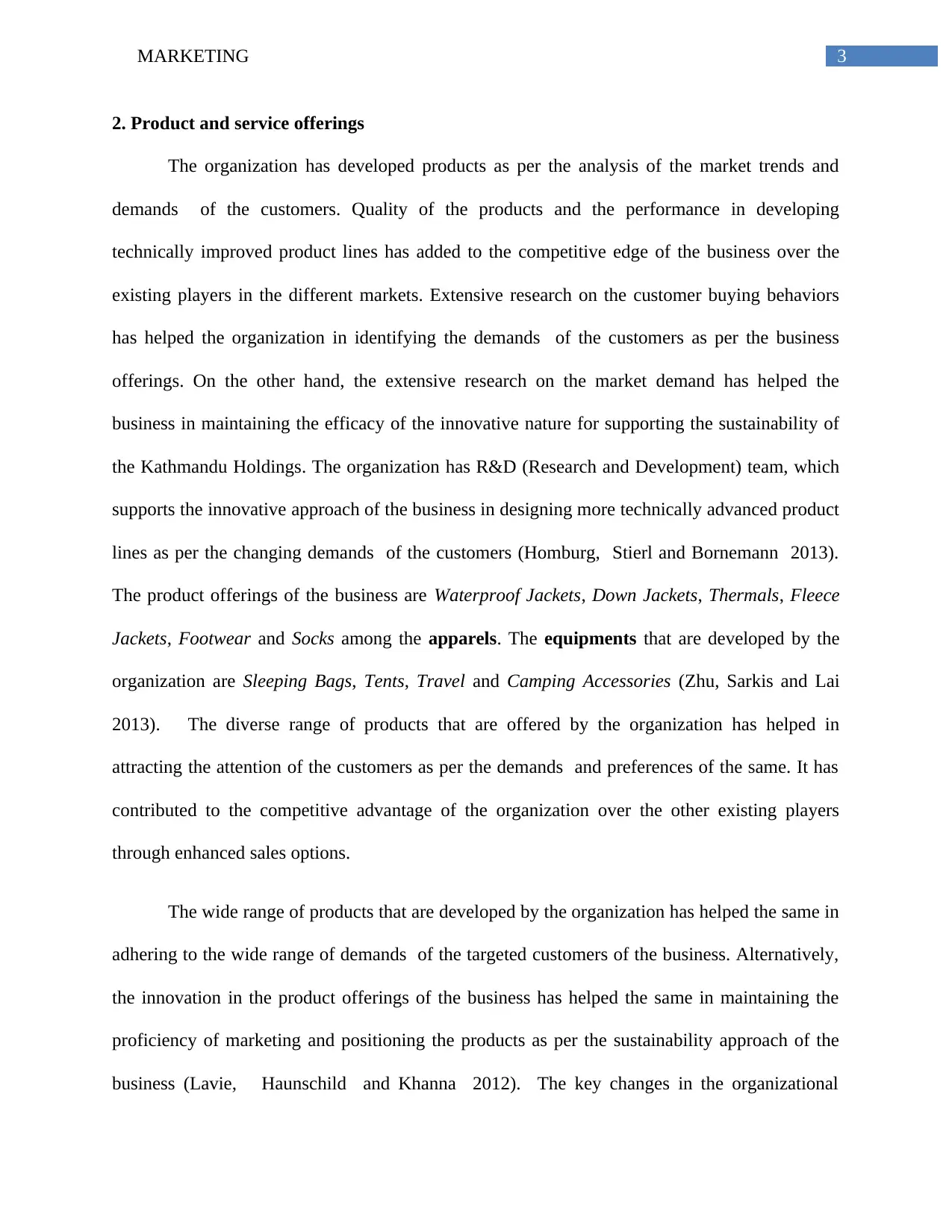
3MARKETING
2. Product and service offerings
The organization has developed products as per the analysis of the market trends and
demands of the customers. Quality of the products and the performance in developing
technically improved product lines has added to the competitive edge of the business over the
existing players in the different markets. Extensive research on the customer buying behaviors
has helped the organization in identifying the demands of the customers as per the business
offerings. On the other hand, the extensive research on the market demand has helped the
business in maintaining the efficacy of the innovative nature for supporting the sustainability of
the Kathmandu Holdings. The organization has R&D (Research and Development) team, which
supports the innovative approach of the business in designing more technically advanced product
lines as per the changing demands of the customers (Homburg, Stierl and Bornemann 2013).
The product offerings of the business are Waterproof Jackets, Down Jackets, Thermals, Fleece
Jackets, Footwear and Socks among the apparels. The equipments that are developed by the
organization are Sleeping Bags, Tents, Travel and Camping Accessories (Zhu, Sarkis and Lai
2013). The diverse range of products that are offered by the organization has helped in
attracting the attention of the customers as per the demands and preferences of the same. It has
contributed to the competitive advantage of the organization over the other existing players
through enhanced sales options.
The wide range of products that are developed by the organization has helped the same in
adhering to the wide range of demands of the targeted customers of the business. Alternatively,
the innovation in the product offerings of the business has helped the same in maintaining the
proficiency of marketing and positioning the products as per the sustainability approach of the
business (Lavie, Haunschild and Khanna 2012). The key changes in the organizational
2. Product and service offerings
The organization has developed products as per the analysis of the market trends and
demands of the customers. Quality of the products and the performance in developing
technically improved product lines has added to the competitive edge of the business over the
existing players in the different markets. Extensive research on the customer buying behaviors
has helped the organization in identifying the demands of the customers as per the business
offerings. On the other hand, the extensive research on the market demand has helped the
business in maintaining the efficacy of the innovative nature for supporting the sustainability of
the Kathmandu Holdings. The organization has R&D (Research and Development) team, which
supports the innovative approach of the business in designing more technically advanced product
lines as per the changing demands of the customers (Homburg, Stierl and Bornemann 2013).
The product offerings of the business are Waterproof Jackets, Down Jackets, Thermals, Fleece
Jackets, Footwear and Socks among the apparels. The equipments that are developed by the
organization are Sleeping Bags, Tents, Travel and Camping Accessories (Zhu, Sarkis and Lai
2013). The diverse range of products that are offered by the organization has helped in
attracting the attention of the customers as per the demands and preferences of the same. It has
contributed to the competitive advantage of the organization over the other existing players
through enhanced sales options.
The wide range of products that are developed by the organization has helped the same in
adhering to the wide range of demands of the targeted customers of the business. Alternatively,
the innovation in the product offerings of the business has helped the same in maintaining the
proficiency of marketing and positioning the products as per the sustainability approach of the
business (Lavie, Haunschild and Khanna 2012). The key changes in the organizational
Paraphrase This Document
Need a fresh take? Get an instant paraphrase of this document with our AI Paraphraser
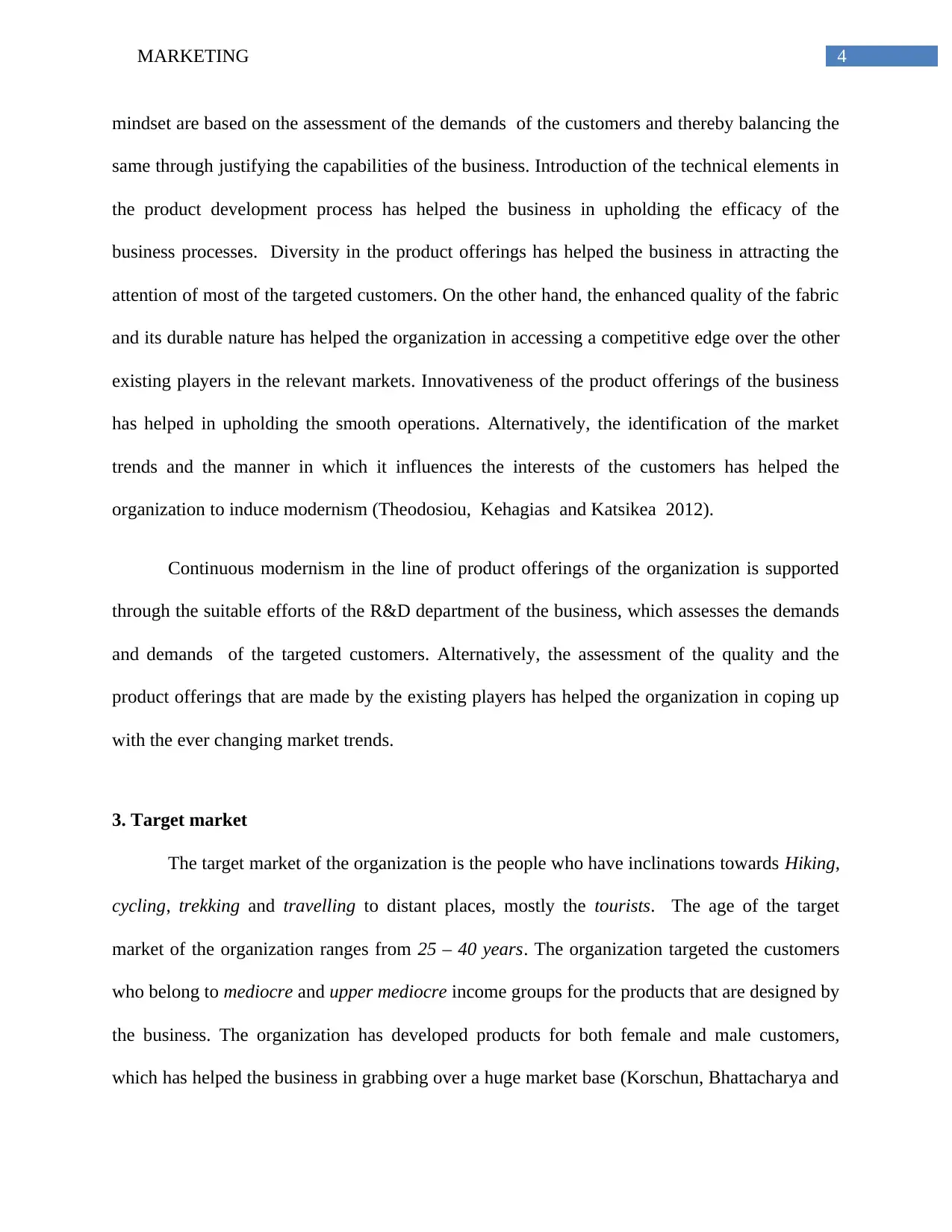
4MARKETING
mindset are based on the assessment of the demands of the customers and thereby balancing the
same through justifying the capabilities of the business. Introduction of the technical elements in
the product development process has helped the business in upholding the efficacy of the
business processes. Diversity in the product offerings has helped the business in attracting the
attention of most of the targeted customers. On the other hand, the enhanced quality of the fabric
and its durable nature has helped the organization in accessing a competitive edge over the other
existing players in the relevant markets. Innovativeness of the product offerings of the business
has helped in upholding the smooth operations. Alternatively, the identification of the market
trends and the manner in which it influences the interests of the customers has helped the
organization to induce modernism (Theodosiou, Kehagias and Katsikea 2012).
Continuous modernism in the line of product offerings of the organization is supported
through the suitable efforts of the R&D department of the business, which assesses the demands
and demands of the targeted customers. Alternatively, the assessment of the quality and the
product offerings that are made by the existing players has helped the organization in coping up
with the ever changing market trends.
3. Target market
The target market of the organization is the people who have inclinations towards Hiking,
cycling, trekking and travelling to distant places, mostly the tourists. The age of the target
market of the organization ranges from 25 – 40 years. The organization targeted the customers
who belong to mediocre and upper mediocre income groups for the products that are designed by
the business. The organization has developed products for both female and male customers,
which has helped the business in grabbing over a huge market base (Korschun, Bhattacharya and
mindset are based on the assessment of the demands of the customers and thereby balancing the
same through justifying the capabilities of the business. Introduction of the technical elements in
the product development process has helped the business in upholding the efficacy of the
business processes. Diversity in the product offerings has helped the business in attracting the
attention of most of the targeted customers. On the other hand, the enhanced quality of the fabric
and its durable nature has helped the organization in accessing a competitive edge over the other
existing players in the relevant markets. Innovativeness of the product offerings of the business
has helped in upholding the smooth operations. Alternatively, the identification of the market
trends and the manner in which it influences the interests of the customers has helped the
organization to induce modernism (Theodosiou, Kehagias and Katsikea 2012).
Continuous modernism in the line of product offerings of the organization is supported
through the suitable efforts of the R&D department of the business, which assesses the demands
and demands of the targeted customers. Alternatively, the assessment of the quality and the
product offerings that are made by the existing players has helped the organization in coping up
with the ever changing market trends.
3. Target market
The target market of the organization is the people who have inclinations towards Hiking,
cycling, trekking and travelling to distant places, mostly the tourists. The age of the target
market of the organization ranges from 25 – 40 years. The organization targeted the customers
who belong to mediocre and upper mediocre income groups for the products that are designed by
the business. The organization has developed products for both female and male customers,
which has helped the business in grabbing over a huge market base (Korschun, Bhattacharya and
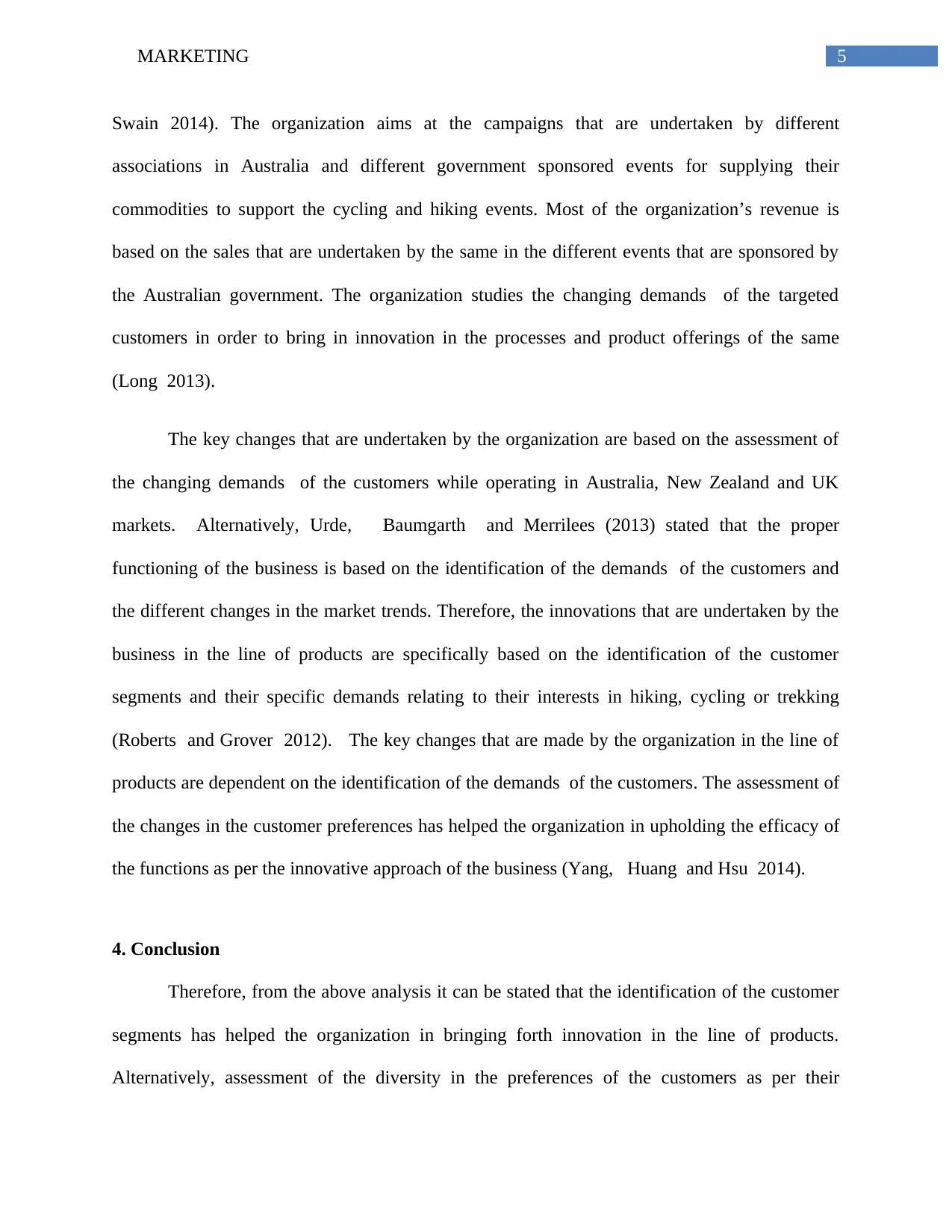
5MARKETING
Swain 2014). The organization aims at the campaigns that are undertaken by different
associations in Australia and different government sponsored events for supplying their
commodities to support the cycling and hiking events. Most of the organization’s revenue is
based on the sales that are undertaken by the same in the different events that are sponsored by
the Australian government. The organization studies the changing demands of the targeted
customers in order to bring in innovation in the processes and product offerings of the same
(Long 2013).
The key changes that are undertaken by the organization are based on the assessment of
the changing demands of the customers while operating in Australia, New Zealand and UK
markets. Alternatively, Urde, Baumgarth and Merrilees (2013) stated that the proper
functioning of the business is based on the identification of the demands of the customers and
the different changes in the market trends. Therefore, the innovations that are undertaken by the
business in the line of products are specifically based on the identification of the customer
segments and their specific demands relating to their interests in hiking, cycling or trekking
(Roberts and Grover 2012). The key changes that are made by the organization in the line of
products are dependent on the identification of the demands of the customers. The assessment of
the changes in the customer preferences has helped the organization in upholding the efficacy of
the functions as per the innovative approach of the business (Yang, Huang and Hsu 2014).
4. Conclusion
Therefore, from the above analysis it can be stated that the identification of the customer
segments has helped the organization in bringing forth innovation in the line of products.
Alternatively, assessment of the diversity in the preferences of the customers as per their
Swain 2014). The organization aims at the campaigns that are undertaken by different
associations in Australia and different government sponsored events for supplying their
commodities to support the cycling and hiking events. Most of the organization’s revenue is
based on the sales that are undertaken by the same in the different events that are sponsored by
the Australian government. The organization studies the changing demands of the targeted
customers in order to bring in innovation in the processes and product offerings of the same
(Long 2013).
The key changes that are undertaken by the organization are based on the assessment of
the changing demands of the customers while operating in Australia, New Zealand and UK
markets. Alternatively, Urde, Baumgarth and Merrilees (2013) stated that the proper
functioning of the business is based on the identification of the demands of the customers and
the different changes in the market trends. Therefore, the innovations that are undertaken by the
business in the line of products are specifically based on the identification of the customer
segments and their specific demands relating to their interests in hiking, cycling or trekking
(Roberts and Grover 2012). The key changes that are made by the organization in the line of
products are dependent on the identification of the demands of the customers. The assessment of
the changes in the customer preferences has helped the organization in upholding the efficacy of
the functions as per the innovative approach of the business (Yang, Huang and Hsu 2014).
4. Conclusion
Therefore, from the above analysis it can be stated that the identification of the customer
segments has helped the organization in bringing forth innovation in the line of products.
Alternatively, assessment of the diversity in the preferences of the customers as per their
⊘ This is a preview!⊘
Do you want full access?
Subscribe today to unlock all pages.

Trusted by 1+ million students worldwide
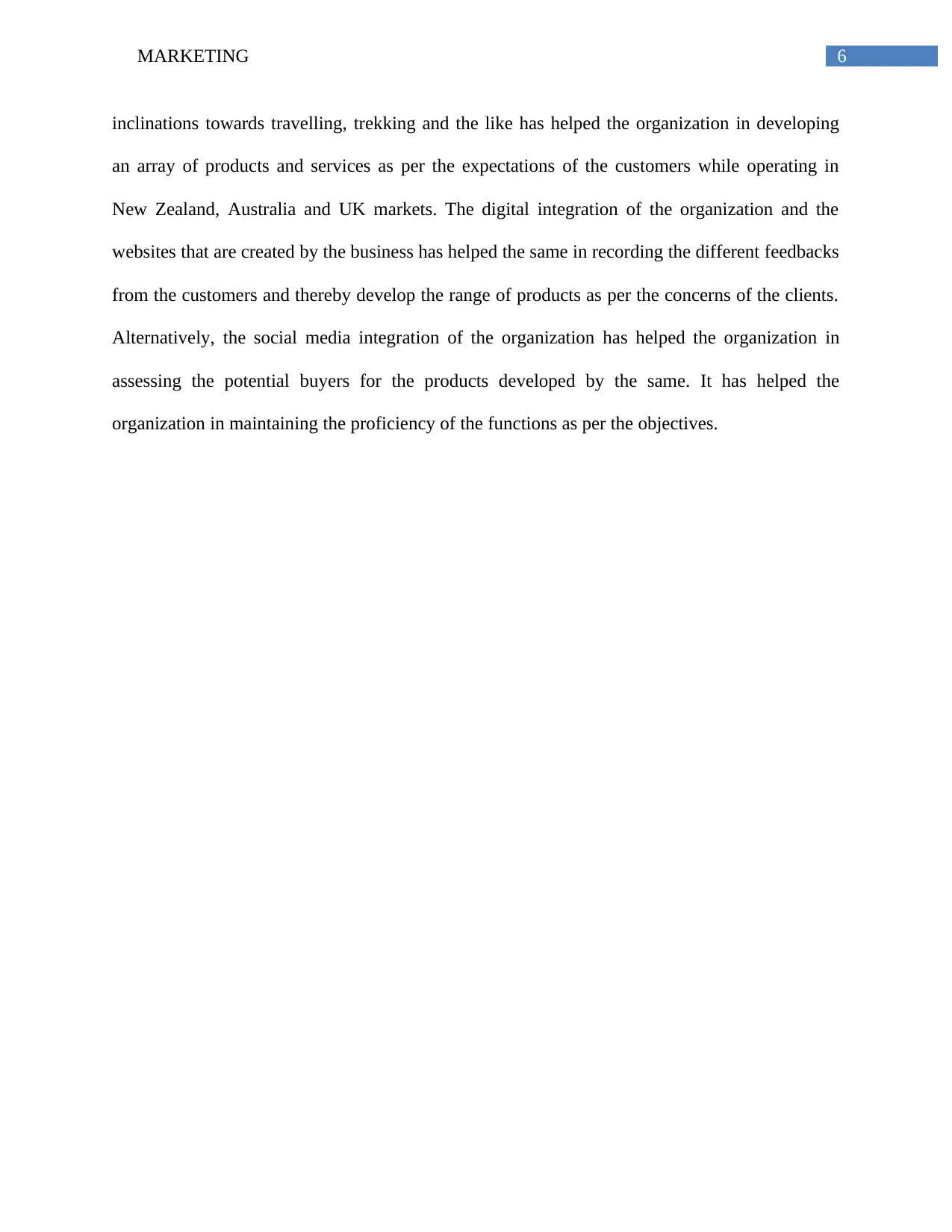
6MARKETING
inclinations towards travelling, trekking and the like has helped the organization in developing
an array of products and services as per the expectations of the customers while operating in
New Zealand, Australia and UK markets. The digital integration of the organization and the
websites that are created by the business has helped the same in recording the different feedbacks
from the customers and thereby develop the range of products as per the concerns of the clients.
Alternatively, the social media integration of the organization has helped the organization in
assessing the potential buyers for the products developed by the same. It has helped the
organization in maintaining the proficiency of the functions as per the objectives.
inclinations towards travelling, trekking and the like has helped the organization in developing
an array of products and services as per the expectations of the customers while operating in
New Zealand, Australia and UK markets. The digital integration of the organization and the
websites that are created by the business has helped the same in recording the different feedbacks
from the customers and thereby develop the range of products as per the concerns of the clients.
Alternatively, the social media integration of the organization has helped the organization in
assessing the potential buyers for the products developed by the same. It has helped the
organization in maintaining the proficiency of the functions as per the objectives.
Paraphrase This Document
Need a fresh take? Get an instant paraphrase of this document with our AI Paraphraser
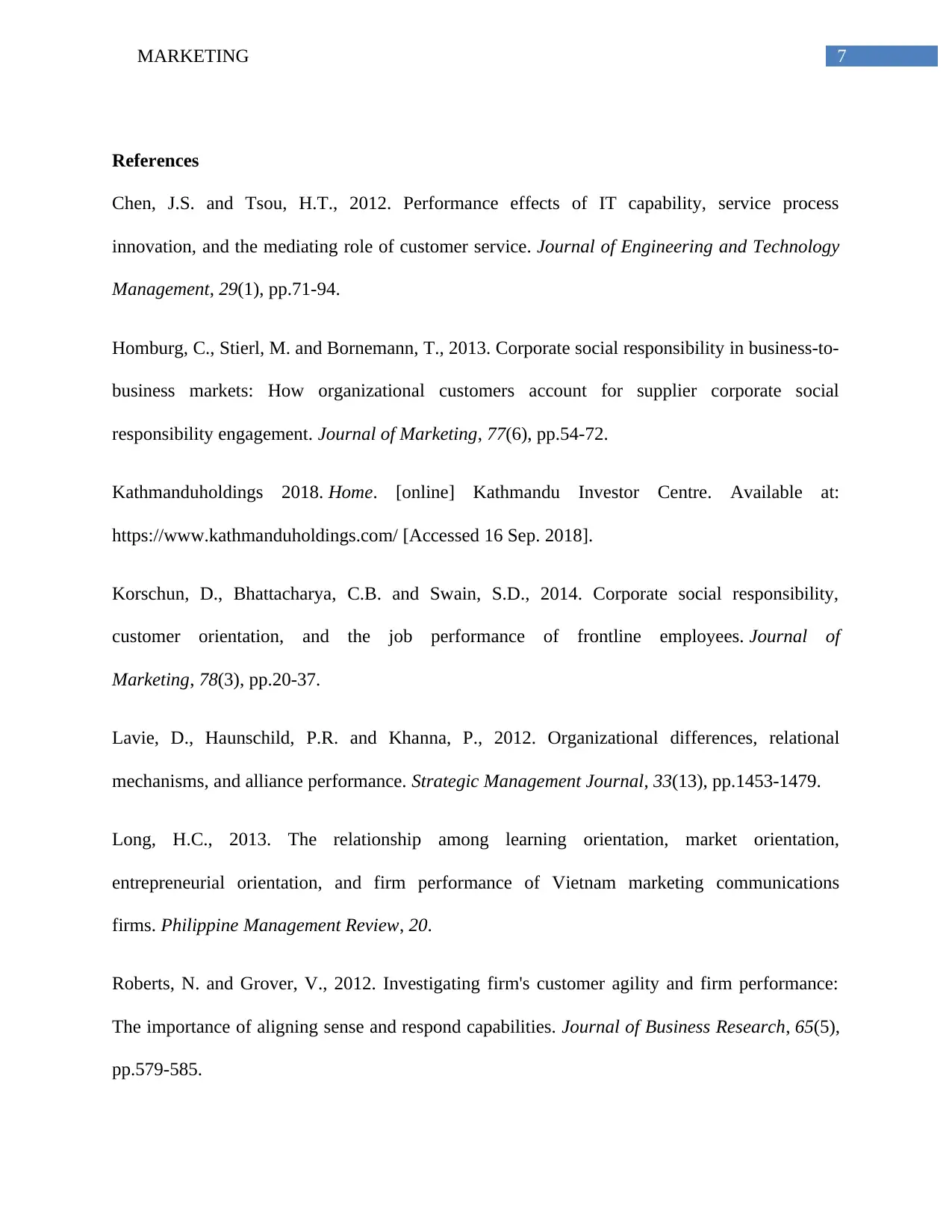
7MARKETING
References
Chen, J.S. and Tsou, H.T., 2012. Performance effects of IT capability, service process
innovation, and the mediating role of customer service. Journal of Engineering and Technology
Management, 29(1), pp.71-94.
Homburg, C., Stierl, M. and Bornemann, T., 2013. Corporate social responsibility in business-to-
business markets: How organizational customers account for supplier corporate social
responsibility engagement. Journal of Marketing, 77(6), pp.54-72.
Kathmanduholdings 2018. Home. [online] Kathmandu Investor Centre. Available at:
https://www.kathmanduholdings.com/ [Accessed 16 Sep. 2018].
Korschun, D., Bhattacharya, C.B. and Swain, S.D., 2014. Corporate social responsibility,
customer orientation, and the job performance of frontline employees. Journal of
Marketing, 78(3), pp.20-37.
Lavie, D., Haunschild, P.R. and Khanna, P., 2012. Organizational differences, relational
mechanisms, and alliance performance. Strategic Management Journal, 33(13), pp.1453-1479.
Long, H.C., 2013. The relationship among learning orientation, market orientation,
entrepreneurial orientation, and firm performance of Vietnam marketing communications
firms. Philippine Management Review, 20.
Roberts, N. and Grover, V., 2012. Investigating firm's customer agility and firm performance:
The importance of aligning sense and respond capabilities. Journal of Business Research, 65(5),
pp.579-585.
References
Chen, J.S. and Tsou, H.T., 2012. Performance effects of IT capability, service process
innovation, and the mediating role of customer service. Journal of Engineering and Technology
Management, 29(1), pp.71-94.
Homburg, C., Stierl, M. and Bornemann, T., 2013. Corporate social responsibility in business-to-
business markets: How organizational customers account for supplier corporate social
responsibility engagement. Journal of Marketing, 77(6), pp.54-72.
Kathmanduholdings 2018. Home. [online] Kathmandu Investor Centre. Available at:
https://www.kathmanduholdings.com/ [Accessed 16 Sep. 2018].
Korschun, D., Bhattacharya, C.B. and Swain, S.D., 2014. Corporate social responsibility,
customer orientation, and the job performance of frontline employees. Journal of
Marketing, 78(3), pp.20-37.
Lavie, D., Haunschild, P.R. and Khanna, P., 2012. Organizational differences, relational
mechanisms, and alliance performance. Strategic Management Journal, 33(13), pp.1453-1479.
Long, H.C., 2013. The relationship among learning orientation, market orientation,
entrepreneurial orientation, and firm performance of Vietnam marketing communications
firms. Philippine Management Review, 20.
Roberts, N. and Grover, V., 2012. Investigating firm's customer agility and firm performance:
The importance of aligning sense and respond capabilities. Journal of Business Research, 65(5),
pp.579-585.
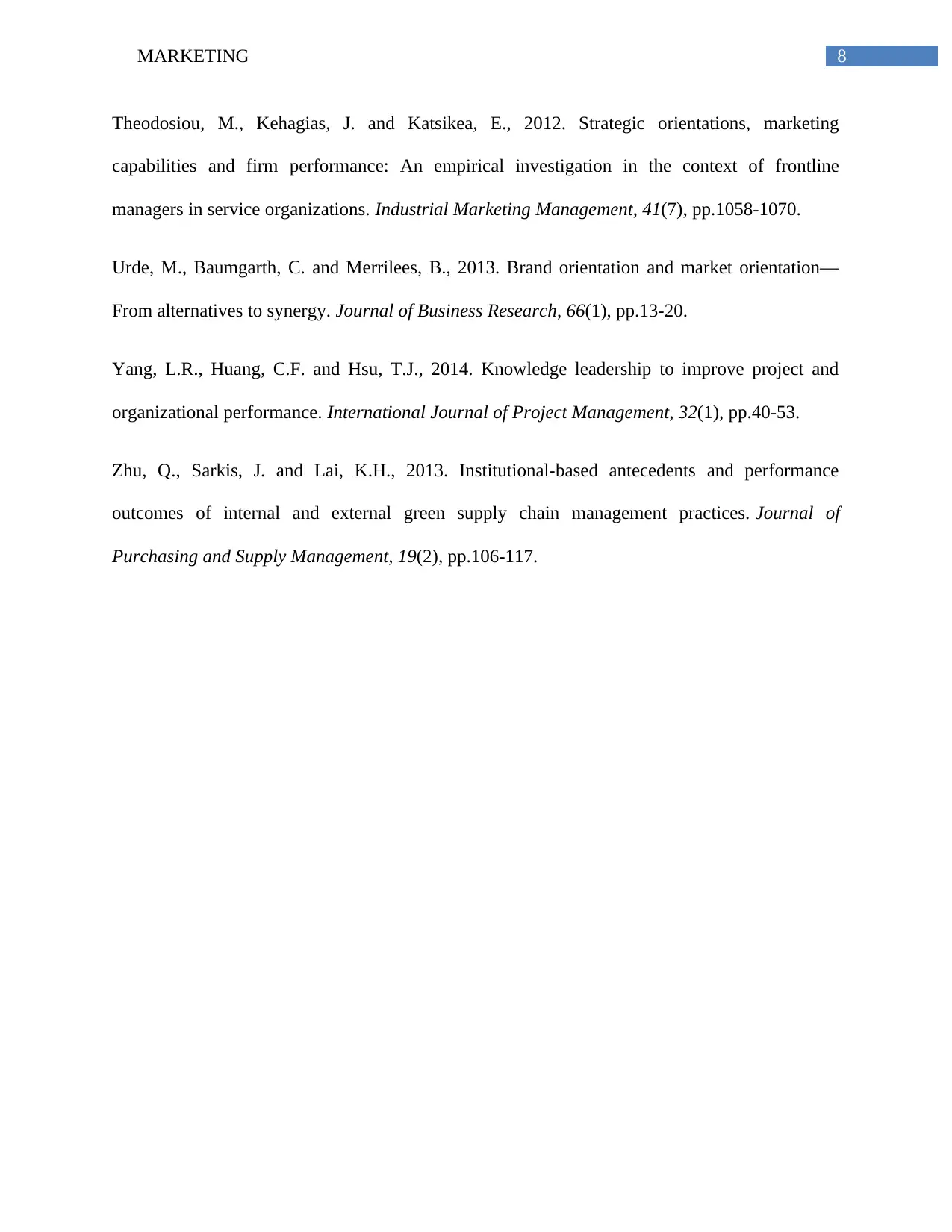
8MARKETING
Theodosiou, M., Kehagias, J. and Katsikea, E., 2012. Strategic orientations, marketing
capabilities and firm performance: An empirical investigation in the context of frontline
managers in service organizations. Industrial Marketing Management, 41(7), pp.1058-1070.
Urde, M., Baumgarth, C. and Merrilees, B., 2013. Brand orientation and market orientation—
From alternatives to synergy. Journal of Business Research, 66(1), pp.13-20.
Yang, L.R., Huang, C.F. and Hsu, T.J., 2014. Knowledge leadership to improve project and
organizational performance. International Journal of Project Management, 32(1), pp.40-53.
Zhu, Q., Sarkis, J. and Lai, K.H., 2013. Institutional-based antecedents and performance
outcomes of internal and external green supply chain management practices. Journal of
Purchasing and Supply Management, 19(2), pp.106-117.
Theodosiou, M., Kehagias, J. and Katsikea, E., 2012. Strategic orientations, marketing
capabilities and firm performance: An empirical investigation in the context of frontline
managers in service organizations. Industrial Marketing Management, 41(7), pp.1058-1070.
Urde, M., Baumgarth, C. and Merrilees, B., 2013. Brand orientation and market orientation—
From alternatives to synergy. Journal of Business Research, 66(1), pp.13-20.
Yang, L.R., Huang, C.F. and Hsu, T.J., 2014. Knowledge leadership to improve project and
organizational performance. International Journal of Project Management, 32(1), pp.40-53.
Zhu, Q., Sarkis, J. and Lai, K.H., 2013. Institutional-based antecedents and performance
outcomes of internal and external green supply chain management practices. Journal of
Purchasing and Supply Management, 19(2), pp.106-117.
⊘ This is a preview!⊘
Do you want full access?
Subscribe today to unlock all pages.

Trusted by 1+ million students worldwide
1 out of 9
Related Documents
Your All-in-One AI-Powered Toolkit for Academic Success.
+13062052269
info@desklib.com
Available 24*7 on WhatsApp / Email
![[object Object]](/_next/static/media/star-bottom.7253800d.svg)
Unlock your academic potential
Copyright © 2020–2025 A2Z Services. All Rights Reserved. Developed and managed by ZUCOL.





